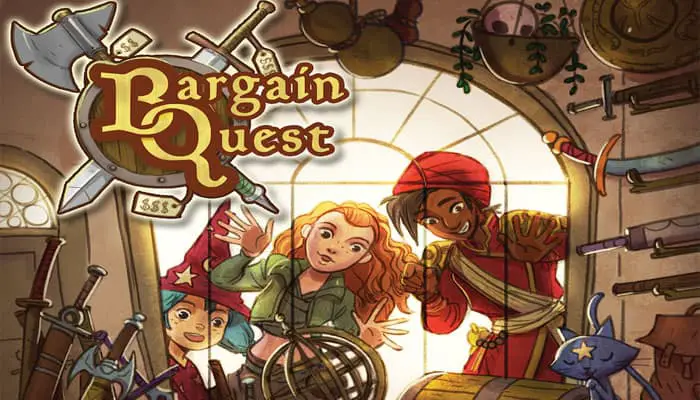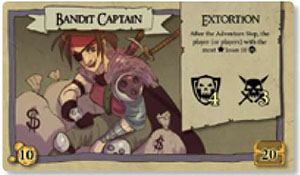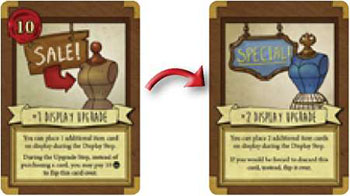
Bargain Quest is a game for 2 to 6 players where you must supply brave heroes with the weapons and equipment they need to save your town. If they succeed, fantastic! Your shop will grow in fame and reputation! And if they get eaten alive, well... at least they can't ask for a refund!
Components
- 120 item cards
- 16 Hero Cards
- 20 Employee Cards
- 12 Upgrade Cards
- 96 coin tokens
- 60 Star Tokens
- 10 Wound Tokens
- 1 Quest Token
- 12 Monster Cards
- 18 Adventure Cards
- 6 folding Item shop Boards
- 1 Rulebook
Card Anatomy

Object of the Game
Your goal is to be the shop with the highest score at the end of the game. Your score is calculated based on the amount of  and
and  tokens you've amassed. These tokens are gained from heroes when they purchase items from your shop and successfully battle monsters.
tokens you've amassed. These tokens are gained from heroes when they purchase items from your shop and successfully battle monsters.
Setup
-
Each player chooses a folding Item Shop Board and places it in his or her play area.
-
Each player takes 5
 from the supply.
from the supply. -
The player who has most recently paid for a good or service in cash claims the quest token and places it next to his or her shop.
-
Shuffle the item deck and place it within easy reach of all players.
-
Create a deck of 3 monster cards by randomly selecting 1 monster from each rank and placing them facedown in the deck as follows: Rank III on the bottom, Rank II in the middle, and Rank I on the top.
Return the unused monster cards to the box without looking at them. (If this is your first game, use the Bandit Captain, Orc Warlord, and Vampire Queen).
-
Shuffle the adventure deck and place it facedown near the monster deck.
-
Sort the upgrade cards into decks, one for Display Upgrades and another for Storage Upgrades. All cards in these decks should have the side displaying the cost in the upper left corner of the card faceup.
-
Take the employee deck, shuffle it, and place it facedown next to the two upgrade decks.
-
Take the hero deck, shuffle it, and place it facedown within easy reach of all players. (If this is your first game, remove 1 copy of each of the following 4 hero cards: Rogue, Fighter, Cleric, and Mage.
Shuffle those cards and place them facedown on top of the shuffled deck).
-
Draw a number of hero cards equal to the number of players and place them faceup in the center of the table. Then, for each hero, place
 tokens from the supply on his or her card equal to the purse value listed in the upper right corner of the card.
tokens from the supply on his or her card equal to the purse value listed in the upper right corner of the card.
3 Player Setup Example

Game Play
There are six steps to each round, for reference these steps are listed in order from left to right on the bottom of your shop board.

Step 1 - Supply
At the start of this step, if the top card of the monster deck is facedown, flip it faceup revealing the current monster.
Monsters have a variety of effects on the game. Some monster abilities occur at specific times, others are always active.
Next, each player is dealt 4 item cards facedown from the top of the item deck. Players take these cards into their hands, without showing them to the other players.
Each player then chooses 1 card in their hand that they would like to draft. To draft a card, place it facedown on your shop board.
Once each player has drafted a card, they pass the remaining cards to the player on their left. The players take up their new hands and draft again.
This continues until all cards have been drafted. Proceed to Step 2 - Display.
Step 2 - Display

At the start of this step each player takes all of the cards they have drafted into their hands and selects one item card from that hand to place on Display, placing it facedown in the display area of their shop board.
Items placed on display cannot be sold this round, but will be used to attract heroes to your shop.
Each item has a number of class icons and a number of heart icons ( ) on the left side of the card. The class icons determine which heroes can equip that item, and the number of hearts is the Appeal value of the item; representing how attractive the item looks in your display. (Some items have zero hearts).
) on the left side of the card. The class icons determine which heroes can equip that item, and the number of hearts is the Appeal value of the item; representing how attractive the item looks in your display. (Some items have zero hearts).
Items also have stat bonuses and/or special abilities that resolve as written.
Once all players have finished preparing their displays, all players flip their display items faceup. Proceed to Step 3 - Shopping.

Step 3 - Shopping

Starting with the player who has the most total  icons in their display, each player will choose 1 available hero from the center of the table to enter their shop, placing it next to their board.
icons in their display, each player will choose 1 available hero from the center of the table to enter their shop, placing it next to their board.
Once a hero has entered a shop, the shop is considered occupied and no other heroes may enter that shop during this round.
Then, the player with the second most total  icons in their display chooses an available hero to enter their shop, and so on until all shops are occupied.
icons in their display chooses an available hero to enter their shop, and so on until all shops are occupied.
While choosing heroes, you must choose a hero that has at least 1 class icon that matches an item in that your display.
Any players who cannot choose a hero that has at least 1 class icon that matches an item in their display must wait until all other players have chosen their heroes.
Then, if none of the heroes in town have at least 1 class icon that matches an item in an unoccupied shop's display, the unoccupied shop with most total  icons chooses one available hero to enter their shop and so on until all shops are occupied.
icons chooses one available hero to enter their shop and so on until all shops are occupied.

If one or more shops have an equal number of  icons, the tied shop with the highest total price of all items in his or her display chooses first, followed by the player with the second highest total price and so on.
icons, the tied shop with the highest total price of all items in his or her display chooses first, followed by the player with the second highest total price and so on.
If multiple shops are still tied, the tied players choose in clockwise order starting from the player with the quest token.
When the last hero has entered a shop, that shop's player claims the quest token.

Once all shops are occupied, you can sell item cards from your hand to the hero in your shop. You can sell any number of items to a hero so long as the item card has an icon that corresponds to the hero's class.

To sell an item, take tokens from the hero card equal to the price of the item card and place that item under the hero card so that the item's bonuses and abilities are displayed.
That item is considered equipped. Remember, you cannot sell any items that are in your display.
Once you have finished selling items to your hero, move the hero card, along with any equipped items and any unspent left on that hero in front of your shop board. That hero will now represent your shop during the Adventure Step.
Once all shops have finished selling items, the Shopping Step ends. Return all item cards in your display to your hand. Proceed to Step 4 - Adventure.
 Note that each hero has a special ability that may affect your decisions during this step. Abilities resolve as written on the hero card. |
Step 4 - Adventure

During this step, the heroes must confront the monster. Each hero is randomly dealt a card from the adventure deck. This card can apply modifiers to the hero's attack and defense values as well as special effects which are resolved as written on the card.
Then, starting with the player who has the quest token and proceeding clockwise, each player resolves the following:
-
If your hero's total Attack value
 (including all bonuses) meets or exceeds the monster's Toughness value
(including all bonuses) meets or exceeds the monster's Toughness value  the hero successfully wounded the monster! Place 1 wound token on the monster and gain 1
the hero successfully wounded the monster! Place 1 wound token on the monster and gain 1  .
.
-

If your hero's total Defense value
 (including all bonuses) meets or exceeds the monster's total Strength value
(including all bonuses) meets or exceeds the monster's total Strength value  , the hero survives the encounter and you gain 1
, the hero survives the encounter and you gain 1  . Otherwise, the hero is defeated. Discard that hero card, all items equipped to that hero, and any
. Otherwise, the hero is defeated. Discard that hero card, all items equipped to that hero, and any  remaining on its card.
remaining on its card.

If none of the heroes successfully wound the monster, place 1 wound token on the monster as together the heroes can still manage to deal a small amount of damage.
After all of the heroes have resolved their attacks and defenses, if the monster has received a number of wound tokens equal to or greater than the total number of players, the monster is defeated and it is discarded.
If there are no monsters remaining in the deck, the game ends and the players proceed to Scoring. Otherwise each hero who survived gains  equal to the value in the treasure chest icon on the bottom right corner of the monster card. Shuffle all adventure cards back into the adventure deck.
equal to the value in the treasure chest icon on the bottom right corner of the monster card. Shuffle all adventure cards back into the adventure deck.
If the monster was not defeated, each hero who survived gains  equal to the value in the coin icon on the bottom left corner of the monster card instead.
equal to the value in the coin icon on the bottom left corner of the monster card instead.
Then, discard all items and adventure cards on the surviving heroes. Return the hero cards to the center of the table with any  accumulated from the Adventure or unspent from Shopping remaining on their respective cards.
accumulated from the Adventure or unspent from Shopping remaining on their respective cards.
For each hero who was defeated, draw another hero card from the hero deck and place it in the center of the table with the other heroes. For each new hero, place P on its card equal to the listed purse value.
Proceed to Step 5 - Upgrade.
Beware! Many monster abilities resolve at the end of the Adventure Step.

Step 5 - Upgrade

Now you have the opportunity to improve your shop with upgrades and employees. Take the top two cards from the employee deck and place them faceup near the upgrade cards, these are the available employee cards.
Starting with the player who has the quest token and continuing clockwise each player may choose to purchase either an upgrade card or an available employee card by paying  equal to the cost listed in the upper left corner of the card, returning that
equal to the cost listed in the upper left corner of the card, returning that  to the supply.
to the supply.
The purchased card is then placed faceup next to the player's shop board.
Upgrade Cards come in two types: The Display Upgrade can allow the player to place additional item cards on display. The Storage Upgrade can allow additional cards to be placed in storage and saved for later rounds.
A shop can cannot have more than 1 of each Upgrade Card type.

Each upgrade card has two levels: +1 and +2. You can pay 10  to flip an upgrade card instead of purchasing a card during the Upgrade Step!
to flip an upgrade card instead of purchasing a card during the Upgrade Step!

Employee Cards each have unique special abilities, the tab in the bottom right hand corner of each card will state the Step when the employee's ability may be used. Using an employee card is always optional.
Whenever an available employee card is purchased, immediately replace it with a new employee card from the top of the employee deck.
If the employee deck is empty when a new available employee card would be placed, no new employees are added.
A shop can cannot have more than 1 employee card with the same name.
Once all players have had the opportunity to purchase a card, shuffle the remaining available employee cards back into the employee deck. Proceed to Step 6 - Storage.
Step 6 - Storage
Each player chooses one item card in their hand to place in storage. When placing an item into storage, place the card facedown on your shop board. All other item cards that were not placed in storage are discarded.

Item cards placed in storage remain face down on the shop board during the Supply Step, they are not considered part of the draft and are taken into the player's hand at the end of the Supply Step. The Storage Upgrade allows a player to place additional cards in storage during the Closing Step.
This is the end of the round! Play proceeds to the next round with Step 1 - Supply!
Running Out Of Cards
If there is a tie, the player with the most P is the winner. If there is still a tie, the tied players share victory.
If the item deck is empty when you must draw or deal a card, shuffle the discard pile to create a new item deck. If the hero deck is empty when a new hero would be drawn, the game ends immediately, see below.
End of the Game
The game ends at the end of the Adventure Step if there are no more monsters remaining. Proceed straight to Scoring. If the hero deck is empty when a new hero would be drawn the game ends immediately; All players lose the game as the monsters take over the town.
Scoring
Each player now calculates his or her final score. Gain 1 point for each  you have collected. In addition, gain 1 point for every 10
you have collected. In addition, gain 1 point for every 10  in your possession (rounded down).
in your possession (rounded down).
The player with the highest total score wins.
If there is a tie, the player with the most  is the winner. If there is still a tie, the tied players share victory
is the winner. If there is still a tie, the tied players share victory
Playing with more than 4 Players
If you are playing with 5 or 6 players these additional rules apply:
During the Adventure Step, if none of the heroes successfully wound the monster, place 2 wound tokens on the monster instead of 1. If only 1 hero manages to wound the monster place 1 additional wound token on the monster.
During the Supply Step, while a Rank II monster card is in play, players pass cards counter-clockwise while drafting.
Advanced 2 Player Variant
For a longer and more strategic two-player game, you can apply the following rule changes:
During Setup, place 4 heroes in the center of the table instead of 2. During the Supply Step, deal 6 cards to each player instead of 4. During the Upgrade Step each player can purchase 2 cards.
During the Shopping Step, after both players have chosen a hero to enter their shops, each player chooses an additional hero, starting with the player with the most total R icons in their display. You can sell items to both heroes in your shop and both heroes will represent your shop during the Adventure Step.
During the Adventure Step the monster is defeated when it suffers 4 wounds instead of 2.
Reliable Heroes Variant
Some players may not enjoy the randomness introduced by the adventure deck, which is intended to increase tension and add a bit of uncertainty to the player's calculations during the Shopping Step. If you would like a more strategic game with more controlled outcomes, apply the following rule changes.
During Setup, set aside the adventure deck and all hero, monster, employee or item cards that reference the adventure deck or adventure cards.
During the Adventure Step do not deal adventure cards to the heroes.
Continue Reading



